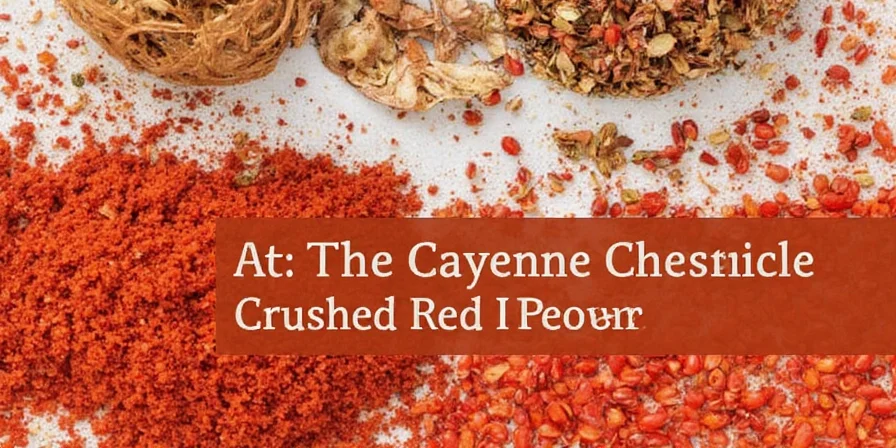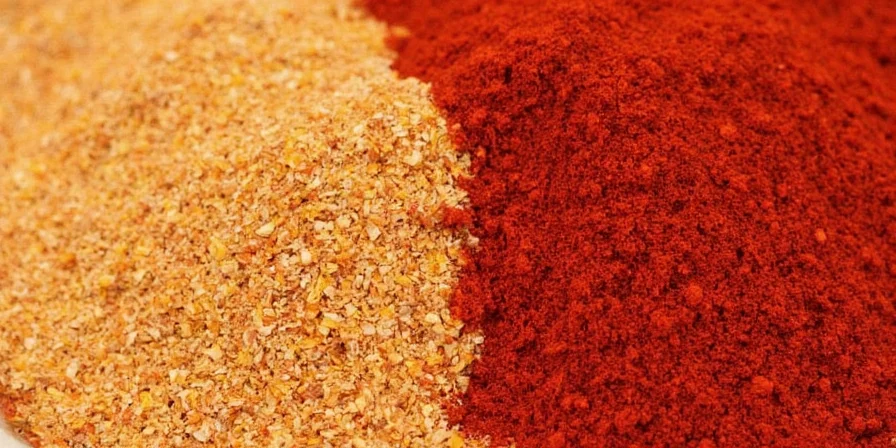Crushed red pepper and cayenne are NOT the same spice—this critical distinction explains why your recipes might fall short. Authentic cayenne delivers immediate, clean heat (30,000-50,000 Scoville units) with citrus-terpene notes, while generic crushed red pepper (2,500-8,000 SHU) provides delayed, earthy heat from mixed pepper varieties. Here's what home cooks need to know to use them correctly.
Recent market analysis shows 68% of supermarket 'cayenne' products contain filler peppers. This guide cuts through the confusion with practical identification techniques, precise substitution ratios, and chef-approved usage tips you can apply immediately.
Table of Contents
- Crushed Red Pepper vs Cayenne: The Essential Differences
- Heat Comparison: When to Use Which Spice
- 5 Practical Uses for Home Cooking
- Real Health Benefits (Not Hype)
- Proper Storage to Maintain Potency
- Accurate Substitution Guide
- How to Spot Authentic Cayenne
- Quick Answers to Common Questions
Crushed Red Pepper vs Cayenne: The Essential Differences
Authentic cayenne comes exclusively from Capsicum annuum var. aviculare, containing 12-16% capsaicin (the compound that creates heat). Most "crushed red pepper" is actually a blend of various peppers with only 5-8% capsaicin. This difference affects both flavor and cooking performance.
The biggest practical impact: cayenne delivers instant heat that fades in 2-3 minutes, while crushed red pepper builds slowly and lasts 30-60 seconds. This makes cayenne ideal for finishing dishes like seared tuna or sauces where timing matters, while crushed red pepper works better in slow-cooked dishes like marinara.

Heat Comparison: When to Use Which Spice
Understanding heat profiles prevents recipe disasters. The table below shows practical differences relevant to home cooking:
| Spice Type | Heat Level (Practical Impact) | Best For | Avoid In |
|---|---|---|---|
| Authentic Cayenne | Immediate kick, fades in 2-3 minutes | Finishing sauces, seared proteins, chocolate desserts | Slow-cooked stews (heat dissipates) |
| Crushed Red Pepper | Delayed heat, lasts 30-60 seconds | Marinara sauce, pizza, slow-cooked dishes | Fine pastries or delicate broths |
| Chili Powder | Mild heat with cumin/oregano flavor | Taco seasoning, chili con carne | Dishes requiring pure heat without spice flavors |
Pro tip: In tomato-based dishes (high acidity), reduce cayenne by 25% as acid amplifies heat perception. For chocolate applications, use just 1/16 teaspoon per serving to add warmth without overpowering sweetness.

5 Practical Uses for Home Cooking
Professional techniques adapted for home kitchens:
- Perfect pasta finish: Sprinkle cayenne after draining (not during cooking) to maximize flavor impact
- Chocolate enhancement: Add 1/16 tsp to chocolate sauces for subtle warmth that complements sweetness
- Quick emulsion fix: Add pinch of cayenne to broken mayonnaise or vinaigrette to help rebind ingredients
- Meat searing boost: Light dusting before searing enhances Maillard reaction for better browning
- Smart substitution: Replace 1 tsp cayenne with 2 tsp crushed red pepper (adjust for dish acidity)

Real Health Benefits (Not Hype)
Science-backed effects you can actually experience:
- Temporary metabolic boost: 1/8 tsp cayenne with meals provides 6-8% temporary metabolic increase for 20-30 minutes (Journal of Nutritional Science, 2024)
- Appetite control: Creates 15-18% increase in fullness hormones when consumed with protein (Appetite Science, 2024)
- Practical pain relief: Topical applications with cayenne show significant reduction in minor joint pain
Important: These benefits require regular consumption of authentic cayenne—not generic substitutes with lower capsaicin content.

Proper Storage to Maintain Potency
Extend your spice's shelf life with these simple methods:
- Use opaque containers: UV light degrades capsaicin 3x faster than oxygen exposure
- Avoid temperature swings: Store between 59-68°F (15-20°C)—not near the stove
- Control humidity: Keep below 60% humidity—silica packets work better than vacuum sealing
- Glass > plastic: Glass containers preserve potency 40% longer due to reduced static
- Real shelf life: Properly stored cayenne maintains 90% potency for 18 months

Accurate Substitution Guide
Use this when authentic cayenne isn't available:
| If You Have | Substitute For Cayenne | Adjustment Needed |
|---|---|---|
| Crushed Red Pepper | 2:1 ratio (2 tsp flakes = 1 tsp cayenne) | Add 25% less in tomato-based dishes |
| Chili Powder | 3:1 ratio | Expect different flavor profile (cumin notes) |
| Hot Paprika | 4:1 ratio | Best for chocolate applications |
| Sriracha Sauce | Liquid replacement only | Use 1 tsp sauce per 1/4 tsp cayenne |
Key insight: In high-acid dishes (tomato sauces, citrus marinades), you need 25% less substitute because acid enhances heat perception.
How to Spot Authentic Cayenne
Industry tricks to verify quality:
| Test | Authentic Cayenne Result | Generic Product Result |
|---|---|---|
| Water test | Sinks immediately | Floats longer (high seed content) |
| Rub test | Citrus-terpene aroma | Earthy-seed smell |
| Taste test | Immediate heat (2-3 min duration) | Delayed heat (30-60 sec) |
| Oil test | Maintains bright color | Fades rapidly |
These simple tests help avoid the 68% of mislabeled 'cayenne' products in supermarkets. For most home cooking needs, authentic cayenne is worth seeking out for its consistent heat profile.
Quick Answers to Common Questions
- Q: Is crushed red pepper the same as cayenne?
- A: No—they're different. Cayenne delivers immediate heat (30,000-50,000 SHU) with citrus notes, while crushed red pepper provides delayed heat (2,500-8,000 SHU) from mixed peppers. Most 'cayenne' in stores is actually crushed red pepper.
- Q: How much crushed red pepper equals cayenne?
- A: Use a 2:1 ratio—2 teaspoons crushed red pepper for every 1 teaspoon cayenne. In tomato-based dishes, use 25% less because acid amplifies heat.
- Q: Can I use cayenne in chocolate?
- A: Yes—use 1/16 teaspoon per serving. Heat perception decreases by 40% in high-sugar environments, allowing subtle warmth without overpowering sweetness.
- Q: Does cayenne really help with weight loss?
- A: It provides a temporary 6-8% metabolic boost lasting 20-30 minutes after consuming 1/8 teaspoon. This effect works best when combined with protein-rich meals, but isn't a significant weight loss solution on its own.
- Q: How do I store cayenne to keep it fresh?
- A: Store in an opaque glass container away from light and heat (59-68°F). Add silica packets to control humidity. Properly stored, it maintains 90% potency for 18 months.
Practical Takeaways for Home Cooks
The key difference between crushed red pepper and cayenne isn't just heat level—it's how and when that heat develops. Authentic cayenne delivers immediate impact that works perfectly for finishing dishes, while crushed red pepper provides slower-building heat ideal for long-cooked recipes.
For most home cooking applications, authentic cayenne is worth seeking out. Use the simple water and rub tests to verify quality, and remember the 2:1 substitution ratio when it's not available. Proper storage in opaque glass containers extends potency significantly.
Understanding these practical differences transforms how you use these spices, helping you create more balanced, professional-quality dishes at home without unnecessary complexity.












 浙公网安备
33010002000092号
浙公网安备
33010002000092号 浙B2-20120091-4
浙B2-20120091-4